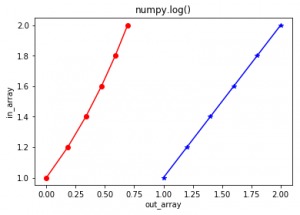numpy.log(x [,out] = ufunc'log1p'):此数学函数可帮助用户计算x的自然对数,其中x属于所有输入数组元素。
自然对数对数是exp()的逆, 以便log(exp(x))= x。自然对数是以e为底的对数。
参数:
array : [数组]输入数组或对象。
out : [ndarray,可选]输出数组,其尺寸与输入数组相同,并放置在结果中。
返回:
自然对数值为x的数组;其中x属于输入数组的所有元素。
代码1:工作
# Python program explaining
# log() function
import numpy as np
in_array = [1, 3, 5, 2**8]
print ("Input array : ", in_array)
out_array = np.log(in_array)
print ("Output array : ", out_array)
print("\nnp.log(4**4) : ", np.log(4**4))
print("np.log(2**8) : ", np.log(2**8))输出:
Input array : [1, 3, 5, 256] Output array : [ 0. 1.09861229 1.60943791 5.54517744] np.log(4**4) : 5.54517744448 np.log(2**8) : 5.54517744448
代码2:图形表示
# Python program showing
# Graphical representation
# of log() function
import numpy as np
import matplotlib.pyplot as plt
in_array = [1, 1.2, 1.4, 1.6, 1.8, 2]
out_array = np.log(in_array)
print ("out_array : ", out_array)
plt.plot(in_array, in_array,
color = 'blue', marker = "*")
# red for numpy.log()
plt.plot(out_array, in_array,
color = 'red', marker = "o")
plt.title("numpy.log()")
plt.xlabel("out_array")
plt.ylabel("in_array")
plt.show() 输出:
out_array : [ 0. 0.18232156 0.33647224 0.47000363 0.58778666 0.69314718]

参考文献: https://docs.scipy.org/doc/numpy-dev/reference/generated/numpy.log.html#numpy.log
。
相关用法
注:本文由纯净天空筛选整理自Mohit Gupta_OMG 大神的英文原创作品 numpy.log() in Python。非经特殊声明,原始代码版权归原作者所有,本译文未经允许或授权,请勿转载或复制。
